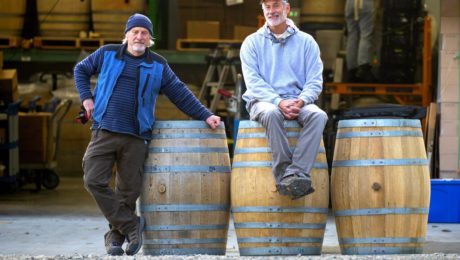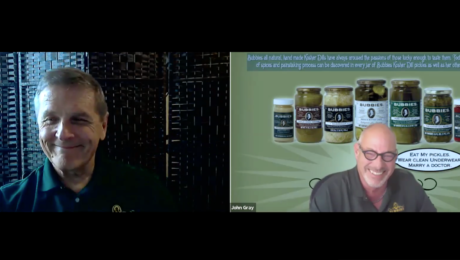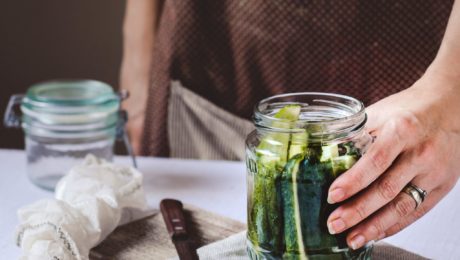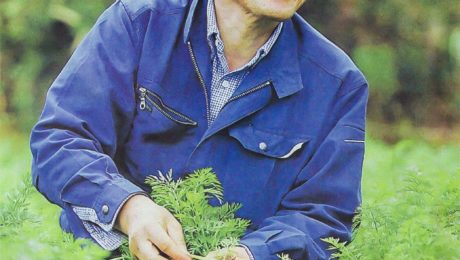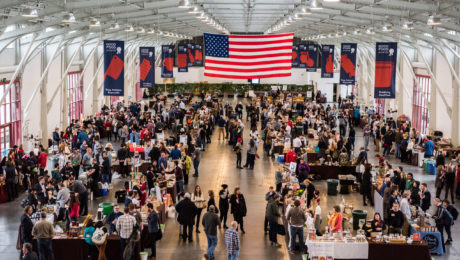Keeping Traditional Fermentation Alive
Britt’s Fermented Foods is one of the only pickle companies in America still using oak barrel fermentation — how pickles were first fermented in ancient Egypt. But this method is often difficult and time-consuming, and many producers abandoned it in the 1970s when food regulation laws changed.
“The oak barrel has that ability to act as an agent in the fermentation,” says owner Britt Eustis. He explained to The Seattle Times that “the tannins in the oak barrels suppress the enzyme that naturally occurs and makes pickles turn soft,” keeping Britt’s pickles crisp.
Britt’s, with a warehouse on Whidbey Island in Washington, nearly shut down in 2019 due to mounting debt and production challenges. But a blueberry farm on the island offered to partner with the company, offering financial backing and helping to diversify income streams. Britt’s now sells kimchi and sauerkraut, also fermented in oak.
Read more (Seattle Times)
- Published in Business, Food & Flavor
Global Fermentation: Today & Tomorrow
The health attributes and unique flavors of fermented food and drink are becoming increasingly more important to consumers. But, for fermentation brands to succeed in the food industry, they must prioritize their labeling and marketing, and focus on their environmental impact, says international food industry expert Lisa Moeller.
“Hopefully, it will be as advantageous to attach ‘Fermented’ as it is ‘Fresh Pack’ to shelf stable pickle products at some point in time,” says Moeller, speaking at a recent TFA webinar: Global Fermentation: Today & Tomorrow. “Never in our history has the power of positive change been more possible and necessary. I think there is an inherent history with fermented vegetables and a trajectory that can only take them higher going forward.”
After receiving her master’s degree in food science, Moeller spent 25 years working with Mount Olive Pickle Company in North Carolina. She later started her own company, Fashionably Pickled, where she consults to food brands on methods – such as assisting with traditional fermentation technology – for crafting better products.
Fred Breidt, microbiologist with USDA-ARS and a TFA advisory board member, called Moeller “one of the premiere pickle people in the United States,” and praised her for working around the world on a variety of fermentations.
Moeller shared three forecasts for fermented foods.
- Health Concerns Become More Important
Consumers are more concerned about their health during the COVID-19 pandemic. “Folks are looking to boost immunity, reduce their weight and they’re looking for nutritious options,” Moeller says.
People are also cooking more at home during the pandemic. Restaurant dining had continually increased over the previous two decades and, in recent years, only half the food eaten in the U.S. was purchased from a grocery store. But when COVID-19 hit, “this 23 year trend was blown out of the water,” says Moeller. By April 2020, 65% of the food consumed came from a grocery store, with less than 35% from restaurants.
“I think this trend gives the fermented vegetable arena great potential,” Moeller says. “Fermented vegetables can increase the shelf life of produce, they’re nutritious, and they can be turned into a wide variety of flavors. And I think for a time, people are going to be more interested in having a supply of things in their pantry when they don’t feel comfortable going to a grocery store.”
Increased research will help promote fermentation as a viable health food. There are still consumers who are off-put by fermentation, leaving room for brands to educate.
“Though a large part of the pickle industry is still involved with fermented cucumbers, it is not the leader in the retail category at this time,” Moeller says. “We don’t label ‘fermented’ in America. Lots of times with the cucumber industry, the fermented kind of becomes the offshoot. It’s kind of the have-to-do so you can produce all the fresh pack that you want and still have a home for others.”
- Labelling and Marketing Are Crucial
Food product labels and marketing must adapt to their local markets. Brands must create different labelling, packaging and marketing plans, depending on the country.
“There truly is no such thing as global tastebuds. But there are successful product adaptations,” Moeller says.
Consider Kentucky Fried Chicken (KFC) as an example. There are over 23,000 KFC locations in 140 countries, and the restaurants adapt to regional flavor preferences, selling different styles of food depending on the location. Coca-Cola is another example. With 500 brands in 200 countries, a can of Coke will taste different depending on the country where it was sold.
“Labelling is even more important when selling your brand. Know what is important to the folks that are going to make the decision to add you products to their store shelves. Whole Foods is different than Walmart,” Moeller adds.
She advises to never make a label too complicated. Yogurt sales are projected to drop by 10% by 2024 “and this is partially because there are too many choices and the category has gotten too complicated.”
- Environmental Concerns Lead to Upcycllng
The environment is a big topic of concern worldwide, Moeller says.The global food system accounts for 26% of greenhouse gas emissions, 40% of the food produced is never consumed and 78% of global consumers are concerned about the environment.
Upcycling will be the new food trend. Brands like Toast Ale (beer made from old bread) and RISE + WIN Brewing Co. (who recycle grain scraps to make granola and sweets) are already making waves in the industry. During the pandemic, chefs reported using fermentation more than ever before to make use of uneaten produce.
“There’s not a vegetable out there that could be turned into something else,” Moeller says. “Turning food waste into alternative products…I think it’s one of the most wonderful ideas, (brands) need to partner with the folks that they want to get these byproducts from.”
- Published in Business, Food & Flavor
Retail Sales Trends for Fermented Food and Beverage
Kimchi, fermented sauces and tempeh are driving growth in the fermented food and beverage category, a $9.2 billion industry that’s grown 4% in the last year.
“We’re excited about the growth potential for fermented food. While fermented food represents about 1.4% of the market today, there are segments that are tracking well above the growth of food and beverage [overall] that are poised for disruption in the future,” says Perteet Spencer, vice president of strategic solutions at SPINS. Spencer shared this information in a recent webinar hosted by The Fermentation Association. “There’s a ton of opportunity to scale and increase the footprint of these products.”
SPINS spent weeks working with TFA to define the fermentation industry’s sales, drilling into 10 fermented product categories and 57 product types. Wine, beer and cheese sales were excluded from the data — those categories are very large, and would obscure trends in smaller categories. (All three are also well-represented by other organizations.)
Pickles and fermented vegetables “is a space that’s seen [a] pretty explosive uptick in growth over the past year,” Spencer says. Every segment is growing — kimchi, sauerkraut, beets, carrots, green beans, sliced and speared pickles and all other vegetables — with pickles the largest, nearly 60% of the category.
The biggest growth, though, is coming from products other than pickled cucumbers. Kimchi is at the center of numerous consumer retail trends. Consumers are purchasing healthier food made with fewer ingredients, and they want food with international flavors. Kimchi makes up only 7% of the category, but sales are increasing at an explosive 90% growth rate.
More people are experimenting with fermenting while they’re at home during the coronavirus pandemic, but these kitchen DIYers do not appear to be detracting from sales.
“The more people make fermented foods, they appreciate what’s available in the store that maybe didn’t exist five or 10 years ago,” notes Alex Lewin, author and TFA advisory board member who moderated the webinar. “Anyone who has made kimchi knows it takes a lot, it makes a big mess, you get red pepper powder stuck under your fingernails and onion in your eyes. I can make kimchi (at home), and then once I’ve made kimchi, I’m like ‘Ok, maybe next time I’ll buy it.’”
Fermented sauces are also growing, up 24% in 2020. The largest segment in sauces is, of course, soy sauce, almost 85% of the category. But gochujang, less than 2% of the category, is increasing at over a 56% growth rate.
Versatility is helping sauces, pickles and fermented vegetables, Spencer says. Any food product with multiple uses is selling well. The condiments and sauces can be used as a topping on eggs, hamburgers or pizza, or mixed-in a salad, rice dish or soup.
Sake, plant-based meat alternatives and miso had combined annual growth of $75 million in 2020. Sake grew 16%, and both plant-based meat alternatives and miso each grew 26%.
Yogurt and kombucha still dominate the fermented food and beverage market. Yogurt is 81% of the market; if yogurt is removed, kombucha is 51% of the remainder.. Both have experienced slowdowns in sales from their peaks. Kombucha sales have slowed recently, as grab-n-go opportunities have shrunk during the pandemic.
Yogurt giant brands Chobani, Yoplait and Dannon still dominate the category, as do GT Kombucha, Health-Ade and Kevita reign for kombucha.
Spencer notes the 4% growth rate of fermented products overall would be higher without yogurt. It’s a large category that — despite an uptick in 2020 during the pandemic – has been fairly flat in recent years. Core (traditional) yogurt has been growing at a 1.6% rate; Greek yogurt, at about twice that pace. Those two segments account for roughly 80% of the category.
“This is an opportunity for disruption for emerging brands,” Spencer says. “We’re already seeing some of the legacy segments start to get disrupted by new innovation, so I’m excited to see the evolution of that innovation and where that goes and kind of what opportunities peek out of that.”
“Overall, we’re seeing historically small segments gaining traction in the marketplace,” Spencer adds. “The pandemic has brought a renewed consumer focus on the fermented space.”
Though fermented products have an added healthy benefit, customers are looking for delicious flavor first.
“In these fermented categories we covered today, taste first is always really important. I think people are going to these categories for different taste experiences,” Spencer says. “If you can level up with a functional benefit, that’s fantastic, but we have to balance the taste first. If it’s highly functional but doesn’t taste good, it just doesn’t have the same success.”
- Published in Business
Prospects For Health-Promoting Pickled Vegetables
There are thousands of molecules in the food we eat, but most have yet to be identified. This is especially true in the world of fermentation.
“Lactic acid is not the only byproduct of lactic acid fermentation,” says Suzanne Johanningsmeier, a research food technologist with USDA-ARS. During a TFA webinar, Johanningsmeier presented her research into health-promoting pickled vegetables. “There could be hundreds or thousands of byproducts of this lactic fermentation. As an analytical chemist and someone who is very interested in the composition of foods, I find that fascinating and exciting and a world to explore.”
Johanningsmeier, a leading expert on the chemical and sensory properties of fermented food and veggies, notes that fermentation is a trending food technique. Consumers today want food that is plant-based, enhances gut health, introduces new flavors, made with simple labels and returns to tradition.
“All these things have aligned and intersected for a fermented foods megatrend. It’s exciting to see so much momentum in the Americas rolling for fermented foods,” she says. “All of these trends are based on the belief that these are health promoting foods for consumption.”
The USDA-ARS office in North Carolina State University is staffed by five research scientists, and there are an additional 2,000 more affiliated scientists across the country. Their mission is to deliver scientific solutions to national and global agricultural challenges.
“My long-term goal is to develop science-based technologies that enable the sustainable preservation of fruits and vegetables for production of high-quality, health-promoting consumer products,” Johanningsmeier says.
The most recent USDA-ARS study explored the potential health benefits of fermented cucumbers. Cucumbers are one of the top five vegetables preserved in the U.S. but the only one that’s not canned or frozen. The USDA-ARS found that fermented and pickled cucumbers include many beneficial by-products, including proline, bioactive peptides and GABA (Gamma-Aminobutyric acid, which works as a neurotransmitter in the brain).
“Food processing has a negative connotation. But, actually, fermentation is processing and, as you can see, processing can be good. Processing can add things and certainly make food available to people year round,” Johanningsmeier says. “I think the idea here is how do we preserve [food] so we retain or enhance those inherent, health-promoting properties? The abilities we have now to more comprehensively look at composition are going to help us understand that in the future.”
Maria Marco, professor of food science and technology at University of California, Davis (and TFA Advisory Board member), moderated the discussion. Marco praised Johanningsmeier’s use of analytical techniques to implement fermentation technologies.
“These are exciting compounds, and we know that they have neuroreactive properties or antihypertensive properties,” Marco says.
- Published in Health
Marketing Fundamentals with Bubbies Pickles
How should an artisanal, fermented food or drink brand spend their time and energy: making the product or selling it?
Both, say John Gray, owner of Bubbies pickles and TFA Advisory Board member, and Steve Rustad, his marketing partner. The two spoke at a TFA webinar “The Bubbies Pickles Story: Food Marketing Fundamentals.”
“You have two jobs if you’re a small businessman. One is making it, the other is selling it,” says Rustad, owner of Rustad Marketing. “If you’re prioritizing making it and putting selling in the back seat, you are not looking at one of the most important parts of your business.”
Marketing should never be considered a distraction — promoting the product needs to be as fundamental to a business plan as making it.
“I’ve seen very few people who can do marketing and making successfully. It is a different world. It takes two people,” Rustad adds.
Sharing Your Brand’s Story
How did Bubbies grow from a small, struggling brand to a financially successful category leader? Good marketing.
Gray, who has a background in finance, decided to purchase the Bubbies brand with his wife, Kathy, in the late 80s. A lawyer friend had recently taken the brand through bankruptcy, and John said he knew that helping the brand survive would “take every last dime we’ve got. And it did.”
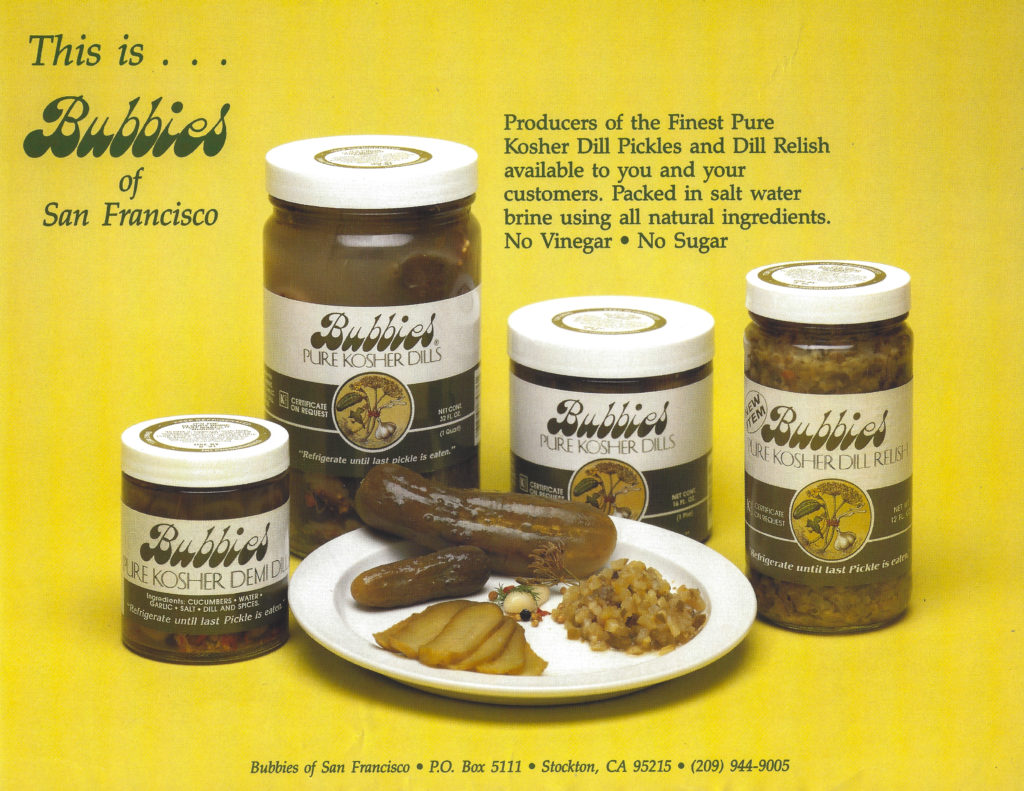
His first step was partnering with Rustad and recreating the label. The original one featured Bubbies written in a bubble font script. It was difficult to read, and people confused “Bubbies” with “Bubbles.” And the image on the label of vegetables wasn’t particularly noteworthy. Gray and Rustad wanted to maintain the old-fashioned look, but in a way that would resonate with customers.
A picture of Kathy’s Jewish grandma Bubbe (Bubbe is the Yiddish word for grandmother) became the inspiration for the label image. She became the mascot, a Bubbe that stands for valuable cooking principles — keeping the kitchen the center of the home, the worth of a home cooked meal and, most important, creating great flavor.
Once the new label was introduced,, sales grew 40% the first three months.
“That’s the power (of a good label),” Gray says. “Your label is your face to the world. And you need to spend the right kind of money until it hurts to get it right because it’s probably the most important money you’ll ever spend.”
To market a product, you need to have a story, Rustad adds. The dream to always ferment vegetables is not a story. “What makes your product unique?”
Bubbies used their quirkiness as a selling point, a strategy Rustad recommends for new, artisanal brands. Don’t look to major consumer packaged good brands for guidance on how to market a maker business. “Your quirkiness is your advantage when you’re a maker,” he says.
Marketing Fermented Products
But how do you market a fermented food or drink, with its own unique qualities?
First, Gray advises, do not become an authority on health food.
“We don’t talk about probiotics at all,” he says. “We make no health claims, we’re very careful about it. One of the reasons I got involved with and wanted to get The Fermentation Association started is because the FDA refuses to deal with what natural is and what it means.”
“If you’re going to talk about your probiotics, you better be legally sure that what the consumer is getting when they crack open the jar is what you are promising them, not just what you made originally,” Gray adds. “As a result, we completely stay away from any claims about health, probiotics or anything else because you can’t prove it.”
Though Bubbies includes all-natural ingredients (cucumber, artesian well water and spices) without sugar or preservatives, Bubbies doesn’t put “natural” on the label, either. Rustad notes, when you try to put “natural” on a product label, it becomes contentious, turning your product into “a magnet for people to sue you.”
The health food is a regulated industry. “As soon as you make any health claims, you’re in bed with the Food and Drug Administration. You really don’t want to do that. So when you talk about your food attributes, you need to be careful that you’re not talking about medicine. Your customers may say your food cures cancer, but you can’t say that.”
Some uninformed customers still consider fermented goods dangerous. Don’t waste time marketing to the uninformed.“It’s very expensive when you have to educate,” Gray advises.
Bubbies in the early years ran into a related problem. Because their pickles and sauerkraut are naturally fermented, the brine is cloudy – a natural byproduct of the fermentation process. Bubbies was unsure how to educate those that thought this cloudiness was a problem. So they made it an attribute of the product, a positive, and, printed “Shake Until Cloudy” on all jars.
Focus on the taste. “If something tastes good, people will put up with a lot of appearance issues,” Rustad says. And taste better than the competition. Bubbies pickles re-launched at a time when big food brands were switching from naturally fermented pickles to processed, shelf-stable varieties.
“By having a naturally fermented pickle, we had a product that was very basic, had no additives other than the spices and was perceived as healthful,” says Rustad . “And tasted delicious.”
Fermented food and drink are difficult to scale, labor intensive and have unique production processes with different liabilities. But people are willing to pay a higher price for an artisanal, fermented product.
“Your market for this product is conditioned to pay a premium for what they perceive to be a superior product. People expect to pay more, ” Rustad says, comparing it to the organic food industry.
Focus on Customers
“Part of that premium should be used for marketing,” he continues. “You need to invest in marketing. And marketing is an investment because you’re buying awareness, you’re buying the tool to establish relevance and hopefully your marketing is provoking trial, action, relationship, social media engagement.”
Bubbies — a certified kosher product — advertised their product in the Jewish press in Los Angeles County in the early days. They knew it was their target audience, and they couldn’t afford advertising in a mass market publication.
Customer rapport has been vital to Bubbies success. Over the years, retailers have replaced Bubbies with different private labels — twice at Safeway and, more recently, at Sprouts. Customers are the first to call and complain to the store’s buyers.
“That happens because of the relationship you have with your customer. Outreach is key. We respond to every single outreach from any customer, whether it’s Instagram, Facebook, email,” Gray says. “How do you relate? People want real stuff. They want real, authentic food, ingredients they can pronounce, that they know what they are.”
- Published in Business
Science Behind Fermented Vegetable Safety
Just because vegetables were fermented does not make them immune to harmful bacteria like E. coli. Though fermentation improves food safety, the quality of the raw vegetable before it’s fermented is extremely important.
“The issue of fermentation safety is one that comes up a lot. People are getting excited about the fermentation world these days, fermentation is increasing in popularity…(but) the wheels can fall off if you’re not careful,” says Fred Breidt, PhD, a USDA microbiologist. Breidt spoke during a recent webinar hosted by The Fermentation Association, “The Science Behind the Safety of Fermented Vegetables.” “The moral of the story: if the vegetables were safe to eat before you ferment them, they’re going to be safe to eat after you ferment them. If they’re not, you’ve got to ferment them for a long time to make sure they’re safe.”
An outbreak of dangerous bacteria in fermented vegetables, “it’s going to be pretty rare that that happens,” Breidt stresses. But, without proper sanitation protocol and vegetable quality control, pathogenic “bad guys” can flourish, like E. coli, salmonella and listeria. E. coli is more common in vegetables because it’s extremely acid resistant, and can survive for long periods of time at low pH levels and cold temperatures.
“Just washing the surface (of the vegetable) isn’t always going to do the trick,” Breidt says. “You don’t have to eat very much to get sick.”
An E. coli outbreak in kimchi made 230 Korean school children sick in 2013. The children, from seven different schools, all ate fermented kimchi made by the same manufacturer.
“If the folks had eaten the cabbage that this kimchi was made out of, they would have gotten sick as well,” Breidt says. “Was the cabbage improved in the sense of maybe it had fewer E. coli on it because of fermentation? Yes. But there was still enough when this was eaten to make a lot of people sick.”
“You can’t rely on salt for safety is the point,” he adds. “It does encourage the lactic acid bacteria and it helps them grow and it will increase overall the safety of your fermentation.”
David Ehreth, president and founder of Alexander Valley Gourmet, parent company of Sonoma Brinery, moderated the webinar. Ehreth first met Breidt when Sonoma Brinery made a few tons of sauerkraut that became infected with yeast. Ehreth says “I called Ghostbusters, and that’s Fred Breidt.” Though yeast is different from a pathogen like E. coli, Ehreth said Sonoma Brinery has managed to control yeast over the years by careful management of production techniques and improved sanitation methods.
- Published in Science
Fermented Sichuan Pickle Bacteria Reduce Cavities
Researchers in China found probiotics from lactobacilli bacteria in traditional Chinese pickles prevent dental cavities. The study, published in the journal “Frontiers in Microbiology,” evaluated 14 different types of Sichuan pickles from southwest China. Of the 14 pickles, 54 Lactobacilli strains were detected. But only one (plantarum K41) was found to significantly reduce “the incidence and severity of cavities.” The strain reduced the cavity-causing Streptococcus mutans bacteria by 98.4%. The S. mutans bacteria is found in plaque on human teeth.
According to the study: “Pickles are an integral part of the diet in the southwest of China. When fruits and vegetables are fermented, healthy bacteria break down the natural sugars. These bacteria, also known as probiotics, not only preserve foods but offer numerous benefits, including immune system regulation, stabilization of the intestinal microbiota, reducing cholesterol levels, and now inhibiting tooth decay.”
Read more (Science Daily)
Farmer, Nutrition Activist Uses Fermentation Methods to Create Healthier School Lunches
An organic farmer and nutrition activist is teaching schools and daycare centers in Japan to grow their own vegetable garden using fermented compost from recycled food waste, then incorporate into school lunches those fresh vegetables with traditional Japanese fermented foods (like miso and pickles). Two years after the program’s launch, absences due to illness have dropped from an average of 5.4 days to 0.6 days per year.
Farmer Yoshida Toshimichi “is a devout believer in the power of microbes.” Using centuries of Japanese folks wisdom that is supported by modern science, Toshimichi explains that fermentation bacteria in the compost yields hardy, insect-resistance vegetables. He says the key to a healthy immune system is maintaining a diverse and balanced gut microbiota. “Lactobacilli and other friendly microbes found in naturally fermented foods can help maintain a healthy environment in the gut, just as they do in the soil,” continues the article. Microorganisms in fermented foods like miso and soy sauce will help balance gut flora. “Organic vegetables, meanwhile, provide the micronutrients and fiber on which those friendly bacteria thrive. In addition, phytochemicals found in vegetables—especially, fresh organic vegetables in season—are thought to guard against inflammation, which is associated with cancer and various chronic diseases,” the article reads.
Toshimichi has authored books on his farming and nutrition practices and is featured in the two-part documentary film “Itadakimasu,” which translates to “nourishment for the Japanese soul.”
Read more (Nippon)
- Published in Food & Flavor, Health, Science
Deli Business Magazine Highlights Fermented Foods
Fermented foods are spiking in popularity in the deli section. A cover story in Deli Business magazine features fermented food offerings in the deli case — from meat, cheese, olives and pickles. Representatives from The Fermentation Association were quoted in the piece, highlighting the unique flavors and health benefits of fermented foods that drive the category. Van Holten’s pickles has seen 13 years of sales growth, with the past two years as their strongest sales growth. Eric Girard, vice president of sales and marketing at Van Holten’s: “Consumers continue to turn away from salty snacks to easy grab and go items that are healthier. Pickles were often a spear at the side of a sandwich, which it still is, but can be a snack. Fermented foods will garner more shelf space in delis in the future, but companies will need to innovate with flavors to keep it fresh and top of mind.”
Read more (Deli Business magazine)
- Published in Business
Dozens of Fermented Food & Drink Brands Win Good Food Awards
Fermented food and beverages reigned at the 2020 Good Food Awards. The annual Good Food Awards honors American craft food producers. Over a hundred fermented brands beat out 1,835 entrants to take home top honors.
Craft food makes over $200 billion in revenue a year. The 17 categories include: beer, charcuterie, cheese, chocolate, cider, coffee, confections, elixirs, fish, grains, honey, oils, pantry, pickles, preserves, snacks and spirits.
From the Good Food Foundation: “For a long time, certifications for responsible practices and awards for superior taste have remained distinct – one honors social and environmental responsibility, while the other celebrates craftsmanship and flavor. The Good Food Awards recognizes that truly good food – the kind that brings people together and builds strong, healthy communities – contains all of these ingredients.”
Read our article for an overview on the fermentation brands that won awards this year.
1000 Faces Coffee – Luis Ordoñez (Athens, Georgia). With a “mission to connect the coffee consumers and coffee producer,” 1000 Faces Coffee is a coffee roaster that travels to countries of origin to work with producers.
21 Degrees Estate Cacao Farm – Kahalu`u Gold (Kaneohe, Hawaii). A family-operated boutique cacao farm on the windward side of the island of Oahu. 21 Degrees sells chocolate and offers tours.
Albemarle CiderWorks – Harrison (North Garden, Virgina). A 20-year-old apple orchard, CiderWorks makes 15 varieties of cider in their cideries, selling by the bottle or by glass in their taproom.
Aldi – VitaLife Organic Ginger Awakening Kombucha (Batavia, Illinois). The fermented tea is made by VitaLife, a brand made by the discount supermarket chain Aldi.
Allagash Brewing Company – Crosspath (Portland, Maine). This independent craft brewer sells beers using a traditional, Belgian method of spontaneous fermentation.
Almanac Beer Co – Apricot Sournova (Alameda, California). Farm-to-barrel brewing, Almanac uses mixed-culture to make their beers, which allows continuous fermentation over months with real fruit in oak barrels.
Apologue Spirited Liqueurs – Saffron Liqueur (Chicago, Illinois). A locally-sourced liquer maker that “elevate classic cocktail recipes.”
Askinosie Chocolate – Dark Chocolate & Red Raspberry CollaBARation™ Bar (Springfield, Missouri). One of Forbes’ 25 Best Small Companies In America, Askinosie Chocolate uses single origin, Direct Trade cocoa beans.
Atlantic Sea Farms – Sea-Chi (Saco, Maine). The first commercially viable seaweed farm in the U.S., Atlantic Sea Farms was founded in 2009. The clean, fresh Sea-Chi is made with raw kelp, cabbage and radish.
Backyard Beans Coffee Co. – Ethiopia Basa (Lansdale, Pennsylvania). A coffee roaster using responsibly sourced coffee beans, the light roast is an Ethiopian heirloom variety.
Barrington Coffee Roasting Company – Gera (Lee, Massachusetts). Sustainable coffee with delicate violet and blueberry aromas with fruit flavors of strawberry, peach and hard candy and soft tones of cocoa, molasses and licorice root.
Beltex Meats – Pate Forestier (Salt Lake City, Utah). A nose-to-tail, whole animal butcher sourcing regional meat, Beltex Meat’s Pate Forestier is part of the in-house charcuterie program. It’s comprised of pork shoulder and liver, chicken liver, and foie gras.
Big B’s Hard Cider – Harry Masters Jersey (Hotchkiss, Colorado). A farmstead hard cider made with fruit from the orchard and fermented in the cidery.
Big Easy Bucha – Bayou Berry Kombucha (New Orleans, Louisiana). A kombucha brand fermented with Southern flavors. Bayou Berry is infused with strawberry and honeysuckle.
Blackberry Farm – Sobrasada (Walland, Tennessee). Sobrasada is Blackberry Farm’s version of a raw, cured, fermented Spanish sausage, made from American Iberico pigs raised at White Oak Pastures in southern Georgia.
Blackberry Farm – Brebis (Walland, Tennessee). Blackberry Farm’s seasonal fresh sheep’s milk cheese.
Blackberry Farm – Hawkins Haze (Walland, Tennessee). An ashed surface-ripened sheep’s milk cheese named after the Hawkins line that runs through the property.
Blue Bus Cultured Foods – Local Cortido (White Salmon, Washington). A sauerkraut popular in Salvadoran cuisine, the organic kraut is made with cabbage, carrots, onions, garlic and spices.
Bourbon Barrel Foods – Imperial Double Fermented Soy Sauce (Louisville, Kentucky). Naturally brewed, double fermented soy sauce. It is aged in bourbon barrels and features earthy flavors.
California Fish Sauce – Koji Fish Sauce (Pleasanton, California). The first fish sauce in the U.S. that is compliant with FDA and FDB regulations, from harvesting anchovies to fermentation and finished product.
Capriole – Sofia (Greenville, Indiana). A sweet, dense, ripened goat cheese from local goats.
Cascadia Creamery – Sleeping Beauty (Trout Lake, Washington). A buttery and sharp cheese with a natural rind, aged 75 to 100 days.
Case Coffee Roasters – Ethiopia Dimtu (Ashland, Oregon). Sustainably sourced coffee from beans all over the globe. Roasted in small batches for sweeter, complex flavors.
Casella’s Salumi Speciali – Casella’s Prosciutto Speciale (Hurleyville, New York). An American made meat made using Italian tradition. Slow, on-the-bone curing.
Castronovo Chocolate – Tumaco, Colombia Dark Milk 60% (Stuart, Florida). A dark milk chocolate made with cocoa from the Pacific coast of Colombia. The cacao beans are foraged in indigenous forests, then fermented and dried in an onsite facility using solar panels.
Champlain Orchards Cidery – Honeycrisp (Shoreham, Vermont). A single-varietal cider using fresh-pressed Honeycrisp apples. All apples are pressed, fermented, and crafted at the orchard.
Champlain Orchards Cidery – Redfield – Estate Series (Shoreham, Vermont). Made with estate grown Redfield apples. These red crab apple hybrids create a fragrant, sour cherry flavor.
Chequessett Chocolate – White Lemon Thyme Bar (North Truro, Massachusetts). A white chocolate with lemon and thyme, the chocolate-making process begins with high-quality beans, then a flavor developed during fermentation.
Cherry Grove Farm – Havilah (Lawrenceville, Nj, New Jersey). Cheese from the cows at Cherry Grove Farm, a sustainable farm. Batches are aged 14 to 16 months.
Cleophus Quealy Beer Company – Frambozenbier (San Leandro, California). Sour red ale barrel-aged with raspberries. Small batches are brewed seven barrels at a time.
Compelling Coffee – Ethiopia Bedhatu Jibicho (Los Angeles, California). Beans are fermented in ceramic tile tanks filled with clean spring water for 24 hours. The beans are then fermented a second time for another 24 hours.
Creo Chocolate – Caramelized Milk Chocolate (Portland, Oregon). The fruit inside the cacao bean is fermented for 4- 7 days to bring out the flavor of the beans.
Crimson Cup Coffee & Tea – Kossa Kebena (Columbus, Ohio). From Crimson Cup’s line of Friend2Farmer direct-trade coffees, Kossa Kebena is produced from heirloom cacao beans naturally fermented on raised beds.
Cutwater Spirits – Three Sheets Cask Strength Rum (San Diego, California). Crafted from pure cane sugar rather than molasses, the rum is distilled in a hybrid pot-and-column still.
Daniel’s Artisan – Bonneville (Ferndale, Washington). Traditional, artisan cheese made through Ferndale Farmstead cheese company. Ferndale uses a seed-to-cheese philosophy, only using milk they produce from cows they raise, fed from crops they grow.
Equator Coffees – Panama Hacienda La Esmeralda Gesha (San Rafael, California). A light roast sustainably sourced from Panama, it features flavors of peach, apricot and Meyer lemon.
Falcon Spirits Distillery – Aperitivo Aplomado (Richmond, California). A blend of 26 high-quality herbs, roots, flowers and fruits with no artificial flavors. Made in small batches that take two months to create.
Fra’ Mani Handcrafted Foods – Salame Toscano (Berkeley, California). All natural pork made in the Tuscan tradition.
Fruition Chocolate – Spring Salted Dark Milk 56% (Shokan, New York). Seeds from pods are fermented in bins and covered with burlap or banana leaves for 3-8 days.
Fullsteam – Farm’s Edge: Barrel-Aged Ava (Durham, North Carolina). A mixed culture saison made with foraged wild grape leaves and elderflower and rested in red wine barrels.
Goat Rock Cider Company – Rosé Cider (Healdsburg, California). A fruit cider made by co-fermenting local, organic apples with Hawaiian passion fruit.
Goodnow Farms Chocolate – Special Reserve with Las Palomas Coffee (Sudbury, Massachusetts). A single-origin coffee and cacao bar, the chocolate is a fruity flavor thanks to the Guatemalan coffee beans.
Gowan’s Heirloom Cider – Macintosh Applewine Cider (Philo, California). A farm-to-table cider, the Macintosh apples used in the cider are grown at Gowan orchards to be pressed, fermented and bottled at the farm.
Gowan’s Heirloom Cider – Gravenstein Cider (Philo, California). Called summer in a glass, the cider is made using fresh Gravenstein apples from the farm’s heritage orchards.
Green Dirt Farm – Fresh – Plain (Weston, Missouri). A fresh, spreadable cheese.
Gypsy Circus Cider Company – PuppetMaster: Whiskey Barrel Vaudevillian (Kingsport, Tennessee). A wild cider aged in whisky barrels for 15 months with apricots.
H+S Coffee Roasters – Kenya Chwele (Laramie, Wyoming). A Kenyan coffee with complex flavors of raspberry, black plum, sour skin, cherry taffy, mango, tropical fruits and stone fruits.
Hemly Cider – Sloughouse Jalapeno Pear Cider (Courtland, California). Made on a six-generation farm, the cider starts with hand-picked Bartlett pears blended with estate grown Gala apples.
HOSAco – The Standard Fermented Hot Sauce (Bellingham, Washington). A condiment made in small batches with all-natural ingredients. Chiles are hand processed and fermented for a minimum of six weeks.
Idyll Farms – Mont Idyll (Northport, Michigan). Named a “Best Artisanal Cheese” by Food & Wine Magazine, the soft ripened rind is delicately painted with vegetable ash.
Incontro Cured – Salame di Bue (Richmond, California). Made from a Sanke River Farms American Wagyu.
Incontro Cured – Salame Sicilia (Richmond, California). Salame honoring the Sicilian lineage, it’s made from ingredients growing wildly throughout the Island of Sicily, Italy.
JAZ Spirits – Cold Tree Gin (Clackamas, Oregon). Inspired by the elegant old growth forests of Oregon, a spirit crafted with flavors of botanical, fruit and old tree harvests.
JAZ Spirits – Verstovia Spruce Tip Vodka (Clackamas, Oregon). A vodka foraged from the coastal forests of the Pacific Northwest, distilled with the fresh green tips of Sitka Spruce trees.
JBC Coffee Roasters – Janson Geisha Lot #109 (Madison, Wisconsin). Direct trade coffee that is named one of the best coffee roasters by Forbes.
Kickapoo Coffee – Kenya Mbeguka (Viroqua, Wisconsin). Made with a Kenyan coffee bean, the coffee is made with a dry fermentation.
Klatch Coffee – Colombia Finca La Maria Geisha Natural (Rancho Cucamonga, California). The highest-scoring coffee at the 2019 U.S. Brewing Championships, the coffee has flavor notes of raspberry, black tea and floral flavors.
KMN Enterprises – K Bloody Mary Mix (Brooklyn, New York). Made in small batches using 87% organic ingredients.
Lakefront Brewing – Beerline Barleywine (Milwaukee, Wisconsin). The nation’s first organic barrel-aged barley wine in the U.S., the beer is held for 18 months in rye whiskey barrels.
Leopold Bros – Summer Gin (Denver, Colorado). Ingredients include Spanish blood oranges, French immortal flowers, juniper berries and Australian lemon myrtle.
Letherbee Distillers – Original Label Gin (Chicago, Illinois). Gin incorporated with a blend of 11 botanical spirits.
Liberty Ciderworks – English Style IV (Spokane, Washington).Classic cider in a aroma-rich, English-style cider.
Linea – Guatemala El Injerto Reserve (San Francisco, California).Coffee from Guatemala’s first carbon-neutral certified farm.
Little Apple Treats – Strawberry + Pink Peppercorn Shrub (Sebastopol, California). Fresh, organic strawberries and fresh, organic pink peppercorn leaves and fruit combine with award-winning apple cider vinegar. It contains live vinegar mother, so it’s potent with probiotics.
Little Beast Brewing – Bes – Tart Wheat Ale (Beaverton, Oregon). Brewed with Belgian malts, Lemon Drop Hops and chamomile flower then fermented with a blend of unique Saccharomyces yeast and conditioned with Lactobacillus.
Little Beast Brewing – Golden Stone (Beaverton, Oregon). A blend of peaches, nectarines and apricots gives a luscious elegance to this farmhouse ale. Prevailing notes of vanilla, toasted French oak & juicy stone fruit.
Loma Coffee – Ethiopia Shantawene Village – Anaerobic Process (Portland, Oregon). Heirloom coffee from Ethiopia, this coffee is anaerobic fermented and tastes floral, sweet and complex.
Love Hard, Inc. – Jojo’s Sriracha – OG (Pueblo, Colorado). Handmade Sriracha made with chile peppers from small farms in Pueblo, Colorado. The chili peppers are harvested in-season and fermented for several months.
Madrone Cider – The Reserve Blend (Friday Harbor, Washington). Naturally fermented in bottle, apples are sourced from Bellevue Farms on San Juan Island, Washington. The hard cider apples are bred specifically for flavor.
Mudhouse Coffee Roasters – Moras Negras, Mi Finquita Coffee Farm (Charlottesville, Virginia). A sundried, natural processing style, the coffee features complex fruit and floral flavors.
My Artisano Cheeses – Ervie Cheese (Cincinnati, Ohio). Washed rind soft cheese with balanced cream, and yeasty notes. Amild version of Belgian washed rind cheeses.
Napili Fresh Local Organic Farm – Pineapple, Ginger, Turmeric Sauerkraut (Lahaina, Hawaii). Artisanal, naturally fermented sauerkraut made in Hawaii with organic ingredients.
Napili Fresh Local Organic Farm – Gut Shots (Lahaina, Hawaii). Kimchi gut shots handcrafted in Maui.
Nettle Meadow Farm – Kunik (Warrensburg, New York). Artisanal goat cheese made on a 100-acre farm.
Oak Cliff Coffee Roasters – Carmen Geisha (Dallas, Texas). A micro-roaster, the Carmen Geisha is a small batch sourced from Finca Carmen in Volcán, Panama
OlyKraut – Eastern European Sauerkraut (Olympia, Washington). One of the most popular flavors, the caraway seeds and apple give it a distinct flavor in the live probiotic kraut.
OlyKraut – Organic Smoke & Kale Sauerkraut (Olympia, Washington). Combines smoked chiles with local kale bounty from Pacific Northwest farmers.
Olympia Provisions – Chorizo Rioja (Portland, Oregon). A Spanish-style salami with both sweet and smoked paprika, garlic and oregano.
Olympia Provisions – Rosette de Oregon (Portland, Oregon). A French-inspired salami made with all Oregon ingredients: Oregon pork, pinot noir, rosemary, juniper, and sea salt.
Oregon Brineworks – Sauerkraut (Hood River, Oregon). Naturally fermented, raw sauerkraut made with organic, lacto-fermented vegetables.
Pagosa Brewing & Grill – Cool Cucumber Wheat (Pagosa Springs, Colorado). A fruit beer infused with fresh cucumbers.
Pappy & Company – Pappy Van Winkle Bourbon Barrel Aged Pure Maple Syrup (Louisville, Kentucky). A one-of-a-kind syrup bursting with flavors of vanilla, butter, oak and bourbon. Aged in Pappy Van Winkle bourbon barrels.
Patric Chocolate – 67% Madagascar (Columbia, Missouri). A limited release bar made from American craft chocolate company from the cocoa bean.
Patric Chocolate – 67% Piura Peru (Columbia, Missouri). Peru cacao beans create chocolate with ruby grapefruit, toasted almonds and sun-dried wine grapes.
Pennyroyal Farm – Reserve Boont Corners (Boonville, California). Made of fresh, raw milk, it is inspired by French cheese as a means of preserving nutrients from the abundant summer milk.
Penstock Coffee – Taaroo Mill, Ethiopia (Highland Park, New Jersey). The coffee is fermented for 24-36 hours, then dried for 12-20 days. The coffee is intensely sweet with heavy fruits.
Perennial Artisan Ales – Giant Steps: Blend 2 (St. Louis, Missouri). A 50/50 blend of two distinct threads: Half puncheon fermented mixed culture saison with grapefruit zest and juice, and half barrel fermented clean saison aged on 2nd use raspberries and blackberries.
Port City Brewing Company – Optimal Wit (Alexandria, Virginia). A a Belgian Witbier style beer, Optimal Wit includes ingredients like Virginia-grown wheat, Spanish orange peels, and coriander.
Port City Brewing Company – Rivershed Ale (Alexandria, Virginia). An American Pale Ale (APA) style beer, Rivershed Ale is dry-hopped with 100% locally sourced grain.
PUSH X PULL COFFEE – Ethiopia Sidama Shantawene Anaerobic Process (Portland, Oregon). Ethiopian coffee with flavors of strawberries and tangerine.
Real Pickles – Organic Nettle Kraut (Greenfield, Massachusetts). Naturally fermented, small batch kraut, infused with Vermont nettles.
Real Pickles – Organic Beet Kvass (Greenfield, Massachusetts). Fermented infusion of beets, onions and savory herbs.
Red Rooster Coffee Roaster – Ethiopia Nansebo Worka (Floyd, Virginia). This washed process organic coffee is sourced from the Zenebe Simbret Washing Station, Flavors include honeysuckle and rose aroma, sweet ripe plum, fresh apricot and pomegranate acidity.
Reuben’s Brews – Hazealicious IPA (Seattle, Washington). An IPA with tropical fruit notes, in particular passion fruit. The stars of the show are the big, bright hops with restrained bitterness providing balance.
Reverend Al’s Bona Fide Potents – Strawberry Peppercorn Shrub (Tacoma, Washington). Reverend Al’s Bona Fide Potents are a collection of all natural, nearly mystical, alchemetical concoctions– magical bitters, elixirs, tinctures and shrubs. Made with locally grown fruits and vegetables from family farms.
Salt and Savour – Apple Ginger Sauerkraut (Dunsmuir, California). Fermented, organic sauerkraut, handcrafted in small batches.
Salute! – Vicario Amore Mio Aperitivo (Greer, South Carolina). Made with a 115-year-old recipe using “vanishing” herbs, hard to find herbal ingredients that Salute now grows themselves.
Shrub Farm – Ginger & Hawaiian Chili Shrub (Bellingham, Washington). A spicy ginger and chili shrub. Shelf stable with a living culture with the Mother of vinegar.
Sierra Nevada Cheese Company – Bella Capra Raw Milk Monterrey Jacques (Willows, California). Made with raw cultured goat’s milk, the “complex array of flavors” results from “naturally occurring healthy micro-organisms present in our fresh milk.”
SILO Distillery – Vodka (Windsor, Vermont). Made with 100% Vermont corn, gluten-free and non-GMO.
Smoking Goose Meatery – Whey Fed Dodge City Salame (Indianapolis, Indiana). Old world style of meat curing with a new world flavor. The Dodge City Salame is a pork salame of fennel pollen and pink peppercorns.
Smoking Goose Meatery – Duck Prosciutto (Indianapolis, Indiana). Moulard duck breast with star anise, allspice and orange peel.
Speakeasy Ales & Lagers – Bootleggers Black Lager (San Francisco, California). Founded in 1997, Speakeasy Ales & Lagers is a San Francisco craft brewery bringing great beer from the underground to the masses. The brewery makes year-round and limited release beers.
Speckled Ax Wood Roasted Coffee – Ethiopia Jebicho (Portland, Maine). Coffee roaster in a vintage Italian Petroncini fired with local hardwood.
Spirit Works Distillery – Sloe Gin (Sebastopol, California). “Batch by batch – grain to glass.” Made with sloe berries, the crimson-colored gin has a unique sweet-and-sour taste.
Spyhouse Coffee Roasting Co. – Juan Domingo / Guatemala (Minneapolis, Minnesota). Rich flavors of chocolate hazelnut and deep fruitiness.
Steady State Roasting – La Pradera Mokka (Carlsbad, California). A Colombian coffee from the mokka tree.
Stem Ciders – New Hampshire Heritage (Lafayette, Colorado). Unfiltered cider made from a blend of bittersharp and bittersweet heirloom apples from a local orchard.
Stonecutter Spirits – Heritage Cask Whiskey (Middlebury, Vermont). The Heritage Cask Whiskey is distilled in Kentucky like a bourbon, aged in Vermont like an Irish whiskey, and finished like a Scotch.
Stormalong Cider – Light of the Sun (Sherborn, Massachusetts). A citrusy, refreshing cider dry-hopped with Citra & Ekaunot hops. At the time of dry-hopping, Stormalong Cider adds guava to enhance the tropical, citrusy taste which is on the drier side.
Sugar Bob’s Finest Kind – Smoked Maple Sriracha (Londonderry, Vermont). Made with real maple syrup, this all natural Smoked Maple Sriracha has become a cult favorite in the state.
Sweet Bloom Coffee Roasters – Mario Alarcon (Lakewood, Colorado). Specialty, ethical, sustainable coffee with limited release flavors, like Mario Alarcon.
The Cottage – Pickled West Indian Gherkin (Bluffton, South Carolina). Pickling cucumbers from The Cottage, a cafe and tea room founded in 1868.
The Juice Hive & Health Emporium – Shiso, Sweet Potato and Asian Sour Leaf Kimchi (Bluffton, South Carolina). A kimchi from the natural foods store.
The Juice Hive & Health Emporium – Watermelon Rind Kimchi (Bluffton, South Carolina). Another unique kimchi flavor from the natural foods store.
Top of the Hill Distillery – Organic Carolina Straight Wheat Whiskey (Chapel Hill, North Carolina). Made from North Carolina-grown wheat and U.S.-grown sugar cane. Fermented and distilled on-site in the distillery.
Treaty Oak Distilling – Ghost Hill Bourbon (Dripping Springs, Texas). Ghost Hill Bourbon is a unique whiskey made with local heirloom grains. A genuine grain to glass bourbon, it is mashed, fermented, distilled, barreled, aged 2 years and bottled on-site.
Underground Meats – Calabrian 3 Ways Salami (Madison, Wisconsin). Wisconsin-grown calabrian chillies, prepared three different ways
Urban Tree Hard Cider – Habanero Haze (Atlanta, Georgia). Spicy ginger infusion with hints of habanero zest.
Vibrant Coffee Roasters – Ethiopia Ardi Organic – Washed (Philadelphia, Pennsylvania). An organic Ethiopian coffee with citrus and sweet floral flavors.
Virtue Cider – The Mitten (Fennville, Michigan). A Michigan cider blend of last season’s pressed apples, aged in Bourbon barrels for up to one year, then back sweetened with this year’s fresh pressed apple juice. The Mitten has notes of vanilla, caramel, and charred oak.
Virtue Cider – Michigan Cherry (Fennville, Michigan). Michigan Cherry blends last year’s harvest of Michigan apples from local orchards that are aged in French oak barrels. Fresh-pressed juice from Michigan cherries is then added.
Vista Brewing – Stonewall Belgian Lambic-Style Ale with Texas Peaches (Driftwood, Texas). Lambic-style ale with Texas peaches.
Volpi Foods – Heritage Prosciutto (St. Louis, Missouri). Our heritage prosciutto is hand-rubbed, salted & air dried for a perfect melt-in-your-mouth texture.
Waialua Estate Chocolate – Hawaiian Milk Chocolate (Wahiawa, Hawaii). Waialua Estate’s Hawaiian cacao is grown along the banks of the Kaukonahua stream. Flavors include banana and pineapple notes, and flavors of dark cherry, berry and raisins.
White Label Chocolate – 58% Brown Butter Milk (Santa Cruz, California). Single origin chocolate bars fermented in a pair box design.
WildCraft Cider Works – Pisgah Heritage (Eugene, Oregon). Traditional farmhouse cider made with apples and English Hawthorne berries & blossoms.
Wise Goat Organics – Super Green Kraut (Hollister, California). Probiotic rich and full of raw, live cultures. Super Green Kraut is full of organic greens: cabbage, nettles, cilantro, morenga, spinach, parsley, chickweed and dandelion.
- Published in Business

